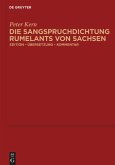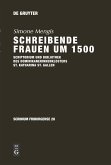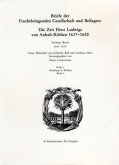Johannes Rothe's Ritterspiegel [Mirror of Chivalry] with its 4108 verses is the most comprehensive medieval knightly primer in German. In all probability it was written for young nobles in the context of Rothe's work as school head in Eisenach from 1414. Apart from its significance for the history of literature as a didactic poem, the work provides a rich source of information on the cultural and legal history of chivalry which focuses the traditional characteristics of the model of social estates on the situation in the 15th century. Rothe's concept of virtuous nobility implies social mobility, i.e. promotion or demotion within the hierarchy of estates. The following are explicated: a history of chivalry, the right to bear arms and seven privileges of the estate, rules on combat and warfare, these being oriented in either a moralising Christian or a purely practical direction, tasks of an army commander, the significance of astrology. The Thuringian text has been newly edited and translated on the basis of the Cassel manuscript; the commentary resolves linguistic issues and historical references and elucidates the source materials for the work.
"Der Ritterspiegel" des Johannes Rothe (4.108 Verse) ist die umfangreichste ritterliche Standeslehre des Mittelalters in deutscher Sprache. Sie wurde für junge Adlige vermutlich im Zusammenhang mit Rothes Tätigkeit als Schulleiter in Eisenach ab 1414 verfasst. Abgesehen von der literarhistorischen Bedeutung als Lehrgedicht, ist das Werk eine reiche Quelle für die Kultur- und Rechtsgeschichte des Rittertums, welche die traditionellen Züge des Standesmodells auf die Situation des 15. Jahrhunderts zuspitzt. Rothes Tugendadel-Konzept impliziert soziale Mobilität, also Auf- und Abstieg innerhalb der Ständehierarchie. Erörtert werden eine Geschichte des Rittertums; das Recht auf die Führung von Wappen und sieben Standesprivilegien; Regeln zu Kampf und Kriegsführung, die christlich moralisierend oder rein praktisch ausgerichtet sind; Aufgaben des Heerführers; Bedeutung der Astrologie. Der thüringische Text wurde auf Basis der Kasseler Handschrift neu ediert und übersetzt, der Kommentar erschließt sprachliche Fragen, historische Bezüge und den Quellenfundus des Werkes.
"Der Ritterspiegel" des Johannes Rothe (4.108 Verse) ist die umfangreichste ritterliche Standeslehre des Mittelalters in deutscher Sprache. Sie wurde für junge Adlige vermutlich im Zusammenhang mit Rothes Tätigkeit als Schulleiter in Eisenach ab 1414 verfasst. Abgesehen von der literarhistorischen Bedeutung als Lehrgedicht, ist das Werk eine reiche Quelle für die Kultur- und Rechtsgeschichte des Rittertums, welche die traditionellen Züge des Standesmodells auf die Situation des 15. Jahrhunderts zuspitzt. Rothes Tugendadel-Konzept impliziert soziale Mobilität, also Auf- und Abstieg innerhalb der Ständehierarchie. Erörtert werden eine Geschichte des Rittertums; das Recht auf die Führung von Wappen und sieben Standesprivilegien; Regeln zu Kampf und Kriegsführung, die christlich moralisierend oder rein praktisch ausgerichtet sind; Aufgaben des Heerführers; Bedeutung der Astrologie. Der thüringische Text wurde auf Basis der Kasseler Handschrift neu ediert und übersetzt, der Kommentar erschließt sprachliche Fragen, historische Bezüge und den Quellenfundus des Werkes.







